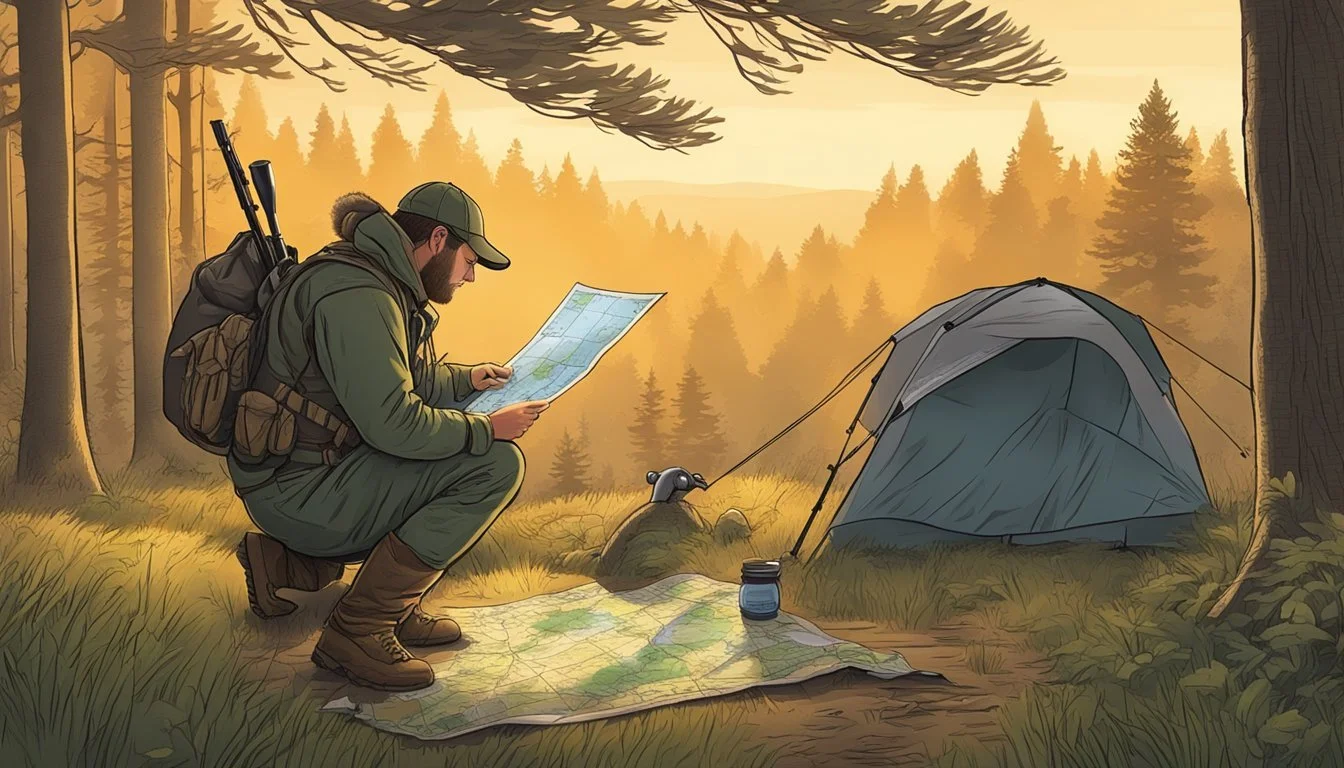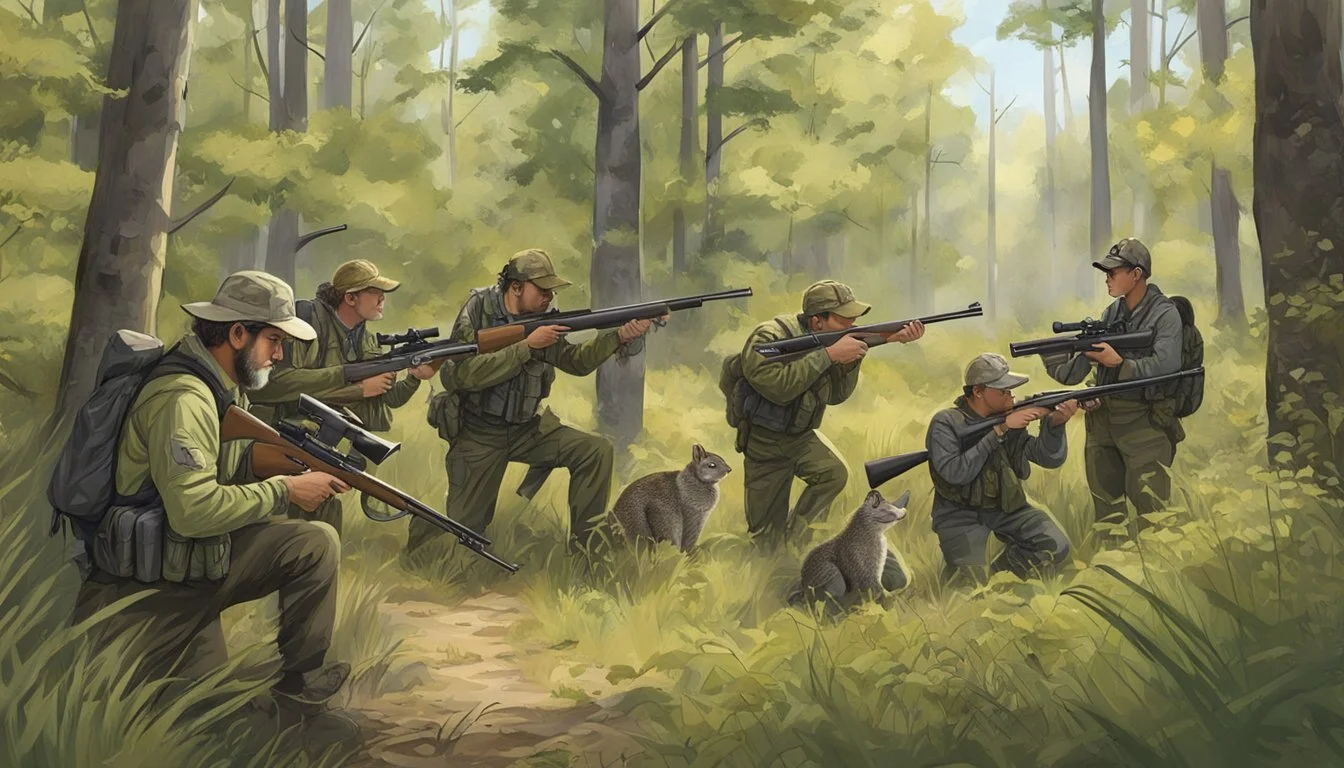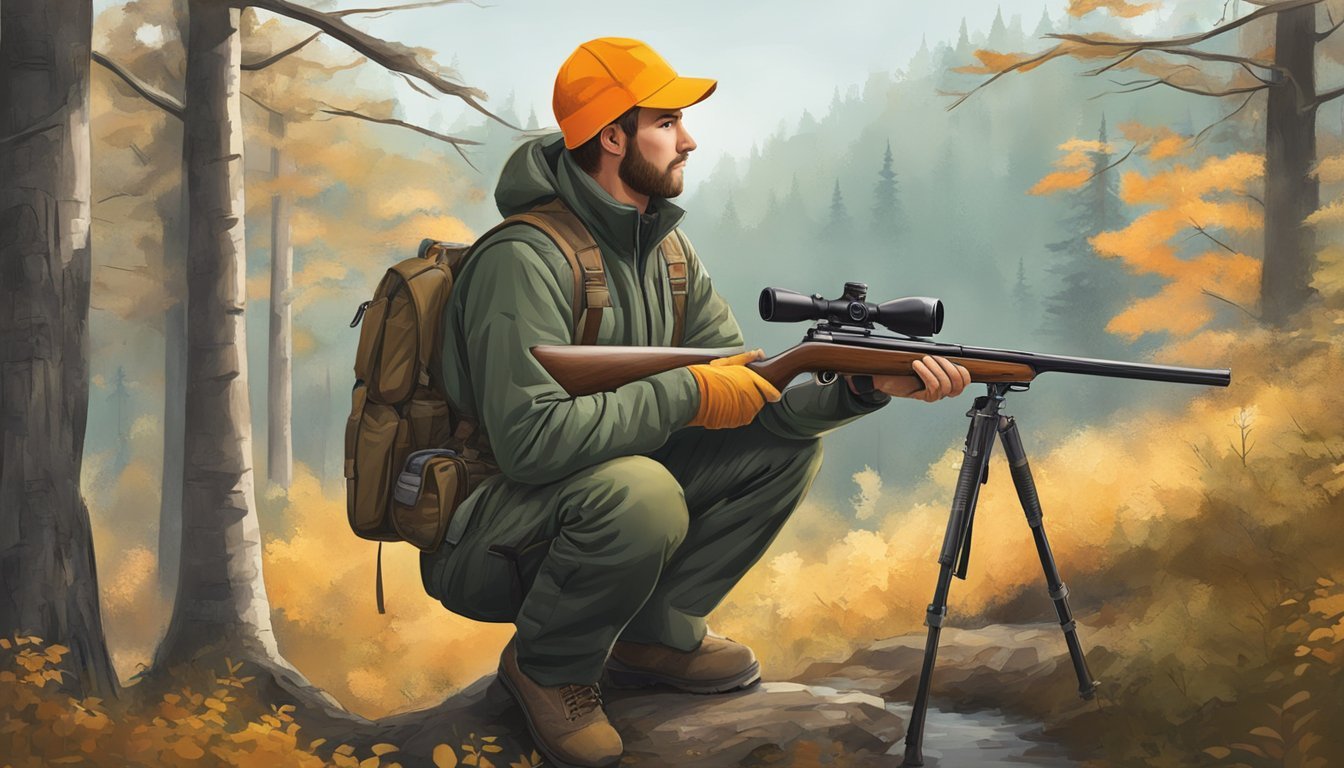Groundhog Hunting for Beginners
Essential Tips and Techniques
Groundhog hunting is a practice that offers both wildlife management benefits and sporting challenge. Groundhogs, also known as woodchucks, are found throughout North America and tend to be most active during the warmer months. Their burrowing habits can damage crops and undermine structures, which is why hunting them is not only a pursuit for recreation but also a means of controlling their population.
To begin hunting groundhogs, one must understand their behavior and habitat. Groundhogs are typically solitary creatures outside of the breeding season, and they can often be found in open fields, along tree lines, or near man-made structures where burrows can be located. Successful hunters scout these areas and learn to recognize signs of groundhog activity such as fresh dirt from dug burrows or clipped vegetation.
The equipment used for groundhog hunting has evolved over the years to ensure humane and effective practices. While smaller caliber rifles were once common, many of today’s hunters prefer high-velocity bolt-action rifles for their accuracy and stopping power at greater distances. This shift reflects an understanding of the need for ethical hunting methods that ensure a quick and humane harvest.
Understanding Groundhogs
To effectively hunt groundhogs, it's crucial to comprehend their behavior, habitats, and the complexities of their burrowing systems. Understanding their preferred diet also aids in locating these animals in their natural environments.
Groundhog Behavior and Habitat
Groundhogs, also known as woodchucks, are primarily active during the day, especially in the early morning and late afternoon. They thrive in a variety of habitats, including open fields, riverbanks, and wooded areas. These rodents are often spotted in central and northeastern parts of the United States, as well as in Canada, where they prefer areas that offer both ample vegetation and cover.
Habitat Preferences:
Open fields and pastures
Wooded edges
Riverbanks and natural water sources
Diet and Food Sources
Groundhogs are herbivores, feeding on a wide array of vegetation. Their diet is composed of grasses, fruits, and the crops found in agricultural lands. They have a preference for leafy greens and can commonly be found foraging in areas with plentiful vegetation such as alfalfa, clover, and soybeans. (how long do soybeans last?)
Primary Food Sources:
Alfalfa and clover
Garden vegetables
Fruits and berries
Groundhog Burrows and Man-Made Structures
Groundhogs are well-known for their destructive burrowing. Their burrows consist of multiple entrances and exits, with intricate tunnels that can be quite extensive. These burrows can pose a threat to man-made structures due to potential damage caused by the undermining. Groundhogs often create holes in and around man-made structures, making them a nuisance to property owners. Additionally, they may utilize brush piles and other debris around properties to hide or build their homes.
Burrow Characteristics:
Multiple entrances and escape routes
Tunnels extending up to 30 feet in length
Located near food sources and cover
Preparing for the Hunt
Before heading out for groundhog hunting, beginners should focus on equipping themselves with the right gear, ensuring all legal requirements are met, and doing preliminary scouting to increase the likelihood of success.
Choosing the Right Equipment
A vital step in preparing for a groundhog hunt is choosing equipment that ensures accuracy and efficiency. For firearms, top weapons for groundhog hunting include .22 caliber rifles, the .223 Rem, and the .17 HMR due to their precision and appropriate range capabilities. Hunters using bows may opt for a compound bow or a crossbow. Scopes and rangefinders significantly enhance a hunter's ability to spot and accurately estimate the distance to their target. For stability, shooting sticks can be a valuable addition. Here is an essential gear list:
Rifles: .22, .223 Rem, .17 HMR
Bows: Compound, Crossbow
Scopes (preferably with a clear magnification for long-range shots)
Rangefinder
Shooting Sticks
Securing Permission and Licenses
All hunters must obtain the necessary licenses to hunt groundhogs legally. As groundhog hunting regulations vary by state, one should check local laws to determine if separate permissions for other species or specific permits are required. Additionally, if the land is privately owned, securing explicit permission from the landowner is crucial. Collectively, these steps ensure compliance with wildlife conservation laws and respect for private property.
Scouting and Trail Cameras
Effective scouting can drastically improve the odds of a successful hunt. Groundhogs are commonly active in the early morning or late evening, therefore, scouting these times can reveal active burrows and feeding areas. Utilizing trail cameras can provide valuable insight into groundhog activity patterns without the hunter needing to be physically present. Hunters should look for signs such as burrow entrances and worn paths in grassy areas. Observing these details aids in identifying promising hunting spots.
Groundhog Hunting Techniques
Groundhog hunting requires precision, patience, and an understanding of the prey's behavior. It's important for hunters to adopt the right shooting stance, master stealthy movements, and consider weather patterns for a successful hunt.
Effective Shooting Positions
When hunting groundhogs, stability is key for accurate shooting. Hunters often rely on the prone position, where they lie flat on their stomach, as this provides the most stability for long-range shots. Utilizing a bipod can further enhance a shooter's accuracy, as it provides a steady platform for the rifle. Other positions like kneeling or standing with the support of a tree or branch can also be effective, especially in areas where tall grass or obstacles prevent a clear line of sight from the ground.
Stalking and Movement
Stalking groundhogs involves a series of carefully planned movements to avoid detection. Hunters should approach with the wind in their face to prevent their scent from alerting groundhogs. They must move slowly, stop frequently to scan the area, and use the terrain to their advantage, keeping low and using natural cover for concealment. Stalking should be methodical, with an emphasis on observing groundhog behavior and waiting for the right moment to take a shot.
When to Hunt: Understanding Weather Patterns
Best times to hunt for groundhogs are generally during the early morning or late afternoon when they're most active. Warm summer days are typically ideal, as groundhogs tend to be out foraging. However, one should be wary of inclement weather— groundhogs are less likely to emerge from their burrows. Additionally, hunters should be mindful of the wind direction as a sudden shift could carry their scent to the prey and cause the groundhogs to retreat.
Strategies for Successful Hunts
Hunters seeking groundhogs must develop keen observation skills and an understanding of the animal's habitat. The approach should be methodical to ensure safety and increase the likelihood of a successful hunt.
Identifying Prime Hunting Locations
Groundhogs, also known as woodchucks, inhabit fields and pastures where they can easily find food sources such as clover and alfalfa. A hunter should look for groundhog burrows around barns, fencelines, and rock walls where the groundhog is likely to build its home for safety and food accessibility. Man-made structures often provide refuge for groundhogs from wild predators. Additionally, areas with stumps and logs can be indicative of groundhog activity as they offer cover and vantage points for these creatures.
Maximizing Visibility and Stealth
For a successful hunt, maintaining a balance between visibility and stealth is crucial. Hunters should position themselves downwind of known groundhog locations to remain undetected. Watching from a distance, preferably with binoculars, allows the hunter to observe without startling the groundhog. Camouflage clothing and slow movements are important when nearing a groundhog's habitat. When in open fields, hunters may benefit from natural blinds or even constructing one as groundhogs have keen eyesight and are easily spooked.
Visibility: Use natural blinds or camouflage.
Stealth: Move slowly, stay downwind, wear camouflage.
Dealing with Wildlife Interactions
Groundhogs, while mostly solitary, share their environment with other wildlife which can be both a hazard and a help to hunters. Predators such as bobcats and coyotes can influence where groundhogs may be found. A good relationship with farmers can be beneficial in gaining insights into groundhog activity and securing permission to hunt on their lands. Hunters should always be respectful of the ecosystem and avoid damaging crops or disturbing the land. Interactions with any wildlife should be cautious, and hunters must always be aware of their surroundings.
When searching for groundhogs, it's important to note that while they favor fields and pastures, they will avoid areas with frequent predation. Observing the behavior of other animals in the area can often lead to discovering active groundhog burrows, as prey species may alter their patterns in the presence of predators.
After the Hunt
After successfully hunting groundhogs, it is important to consider the utilization of the harvest and understand the role of ethics and conservation in the practice.
Utilizing the Harvest
Groundhog meat is often utilized as a food source, providing a unique option for those interested in game meats. For preparation, the meat should be cleaned properly and cooked thoroughly to ensure safety and enhance flavor. Recipes may include braising or slow-cooking techniques to tenderize the meat. Many hunters view this as an opportunity to add diversity to their diet and honor their harvest by minimizing waste.
Cooking Instructions:
Clean the meat with cold water.
Marinate or season as desired.
Cook slowly until tender.
Farmers often benefit from groundhog hunting as it can reduce the damage these animals cause to crops and livestock, especially considering the groundhogs' appetite for young plants in grasslands. This makes the practice not only a pursuit for food and fun but also a service to local agriculture.
Ethics and Conservation Efforts
Ethical hunting practices ensure that the groundhog population is not at risk of going extinct. Groundhog hunting is often carried out in accordance with wildlife management plans that aim to balance the ecosystem, which can be disrupted by the rise of coyotes and bobcats who also prey on groundhogs. By hunting during seasons when groundhogs are not in hibernation, hunters avoid disrupting their natural life cycle.
Hunters are encouraged to adhere to the following guidelines to promote conservation:
Hunt only within the legal season and abide by bag limits.
Respect private property and secure permissions from landowners.
Small game hunting, including that of groundhogs, contributes to the control of animal populations and supports grassland management efforts. It's also part of maintaining a tradition that can be found in small game hunting stories, which often involve camaraderie and the sharing of knowledge among the young and experienced alike. Hunting ethics and conservation go hand-in-hand to ensure that the tradition of groundhog hunting can be continued responsibly.
Connecting with the Hunting Community
The hunting community is a great resource for beginners to learn, share, and connect with experienced hunters. It's an invaluable way to gain insights and tips on groundhog hunting.
Sharing Experiences Online
Individuals new to groundhog or woodchuck hunting can greatly benefit from sharing their experiences with others online. Facebook groups dedicated to hunting can be a good starting point. They allow for:
Discussions: Hunters can post questions, share stories, or provide updates about their hunting trips.
Photos and Videos: New hunters can observe techniques and learn from the visual content posted by others.
Learning From Others
Learning from more seasoned hunters can accelerate a beginner's skill development. Methods to engage with the community for learning include:
Joining Local Hunting Clubs: Many communities have local clubs where hunters gather to share knowledge.
Online Forums: Websites like HuntingPA.com Outdoor Community offer a platform where hunters can discuss groundhog hunting nuances and read about others' experiences in various terrains.
Common Challenges and Solutions
In the pursuit of groundhog hunting, novices often grapple with environmental elements and the need for effective fieldcraft. These challenges can be mitigated through understanding and preparation.
Contending with Environmental Factors
Groundhogs possess a keen sense of smell, which they use to detect predators from afar. Hunters must pay attention to wind direction to ensure their scent does not betray their presence. Flies and gnats can also be a distraction, potentially impacting the hunter's focus and accuracy. The simple yet effective technique of wearing a head net can alleviate this issue. Additionally, to gauge wind direction and verify they are downwind of their quarry, hunters can spread flour or a similar fine powder into the air as a visual indicator.
In terms of distance, a groundhog's vision is sharp enough to notice human movement from long ranges. By wearing at least olive drab colored clothing and moving cautiously, hunters can reduce their visibility.
Fieldcraft and Improvisation
The unpredictability of natural terrains calls for adaptive tactics. Groundhogs can be particularly destructive to fields and crops, which is why they are often sought by hunters. To increase their chances of a successful hunt, individuals should focus on integrating into the environment seamlessly.
They should seek out elevated positions which grant a clear line of sight for spotting these animals while also keeping the hunter's profile discreet. Camouflaging with the environment is crucial, meaning clothing and gear should match the surrounding terrain.
Improvisation plays a key role; for instance, if a groundhog vanishes into its burrow, patience is necessary, as these creatures frequently re-emerge to check for danger or continue foraging. The strategic placement near groundhog burrows can offer a prime opportunity when they resurface.
Safety and Legal Considerations
When embarking on a groundhog hunt, hunters must prioritize safety and adhere to legal requirements. A successful outing is not just about the hunt; it also involves understanding the laws and taking appropriate safety measures to protect oneself and the environment.
Legal Regulations and Ethics
Every hunter is responsible for obtaining the necessary hunting license before they embark on a groundhog hunt. Licenses are typically issued by state wildlife agencies and may vary according to one's age, residency, and other factors. It is important to note that:
The legality of hunting groundhogs can vary by state or region.
Some states may have a designated season for groundhog hunting.
Hunters should ensure that their activities contribute to wildlife conservation and do not negatively impact local ecology or livestock.
Personal Safety in the Field
Safety in the field is paramount. Hunters should always handle firearms with care and be aware of their surroundings to minimize risks. Here are key safety recommendations:
Wear appropriate safety gear, such as blaze orange, to remain visible in the woods.
Be aware of your target and what is beyond it to prevent accidents.
Inspect hunting equipment regularly to ensure that it is in good working condition.
Learn to safely navigate the terrain to avoid injuries and protect against falls.
Remain vigilant for signs of other wildlife that may pose danger.
Remember, a hunter's preparedness and respect for legal and safety considerations are crucial for a successful and ethical groundhog hunt.








